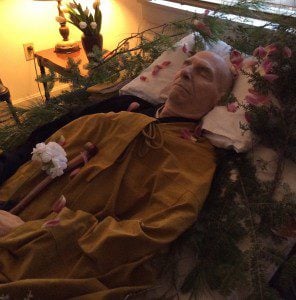
Above is Zenshin Tim Buckley, a friend and fellow traveller on this Zen way, who died on April 16, 2015. You can read more about Zenshin here.
We’re not here today, though, to memorialize Zenshin but to ask, “Who is it that dies?”
You can read the run up to this post, “Birth Death and Intimate Self Knowledge,” here and listen to a talk about it here. In this post, I’ll unpack a kōan from the No Gate Barrier (Wúménguān 禪宗無門關) collection, “CASE 47: Dōushuài’s Three Barriers” (my translation). In plain English, the three barriers are, Who am I? What is death? And what happens after death? All essential human questions.
Case:
The happy old monk Dōushuài, set up three barriers to ask students.
“Parting the grasses, participating in the mystery, only seeking to meet [essential] nature. Right now, honored one, where will you know this self nature?
“Just when birthdeath is shed, when vision falls away, what will you do?
“Birthdeath shed, then [you] know [your] destination. The four elements separate, where will you go?”
First a word about Dōushuài (1023-1104). He was a teacher in the Huánglóng branch of Línjì. The scholar, Steve Heine, associates this branch and the Cáodòng lineage (Japanese, Sōtō) with the entangling-vine approach to kōan introspection rather than the key-phrase method of the Línjì branch associated with Dahui. It was this Huánglóng branch that Dōgen inherited from his first teacher and esteemed sufficiently to include on his blood vein (kechimyaku). It is still transmitted today in Sōtō Zen.
Wúmén introduces Dōushuài in an unusual way with an adjective before “old monk” (Japanese, ōshō), a rare thing in the kōan collections. Dōushuài is a “happy” old monk, no less. We like him already. Dōushuài’s “happy” old monkness is not apart from resolving these three questions and having the chance to pose them for others.
Who Am I?
First,“parting the grasses, participating in the mystery, only seeking to meet [essential] nature. Right now, honored one, where will you know this self nature?”
“Grasses” in “Parting the grasses” refers to the wild world of delusion. And “parting” is a practice instruction for how to work with delusion – touching and letting go.
“Participating in the mystery,” could also be “participating the darkness.” Again, a practice instruction. With grasses extending to and darkening the sky, take a step.
Why? “Only seeking to meet [essential] nature.”
If you want to find freedom in this question, you’ll probably want to organize your life around your practice, rather than fit in your practice in when your life allows. Only seeking essential nature. It isn’t something for some other time but for “right now.” Show some self respect, “honored one.”
Aitken Roshi’s translation has the last phrase as “Where is your nature?” but this leaves out a sinograph or two. I read it as “Where will you know this self nature?” The kōan is a narrow gate and penetratingly specific.
What is death?
“Just when birthdeath is shed, when vision falls away, what will you do?
For “Just when birthdeath is shed,” Aitken Roshi has “When you have realized your self-nature.” His approach explains what is meant by “birthdeath shed.” I prefer to stay close to the sinographs here – just drop birthdeath. “Shed” (or “drop”) is 脱, the same character Dōgen used in “shed bodymind.” No need to paste a belief system – heaven/hell, rebirth, you name it – on top of it. All that is clinging to and swirling in birthdeath. So the practice instruction – just shed birthdeath and what death is (“what you will do when you die?”) will be crystal clear.
What happens after death?
“Birthdeath shed, then [you] know [your] destination. The four elements separate, where will you go?”
Likewise, when birthdeath is shed and you’ve realized intimate self-knowledge, when the cells of “your” body (i.e., earth, water, air, and fire) begin to decompose, you’ll know where you go. No need for idle speculation. This is why Zen has been handed on through the generations.
Enter the dark mystery completely and birthdeath will be completely dropped. Who you are, what death is, what happens after death are all clear.
When it’s already raining, no need to water the lawn.
Wúmén’s Comment:
If you can arrive at three turning words, then [you] can take responsibility everywhere, meet karma and approach the [school of the] ancestors. Before this happens, a coarse meal will easily satisfy, [but] when hungry, subtle chewing is a problem.
Wúmén’s voice, as usual, is clear and strong. The last sentence is worth a quiet sit or two. Lost in the swirl of the world, we can wolf down our food – drugs, sex, rock n roll. When we turn to practice, make only seeking self nature the central organizing principle, we begin the subtle chewing of sitting, study, and engagement. The hunger to realize and the need for subtle chewing are the two foci that rub together and heat the room on a cold morning.
Verse:
One nen is the universe seeing the immeasurable kalpa.
The immeasurable kalpa is this matter now –
Now sees the broken one nen.
Seeing the broken now is seeing the essential person.
I’ve left “nen” (念) untranslated because the multiple nuances of the term make it difficult to find one fitting English word. The sinograph is composed of “now” above and “heart/mind” below. It means “thought,” “memory,” “remembering (as in nenbutsu, remembering buddha),” “moment,” and is the sinograph that is translated as “mindfulness.” The closest I can come to capture aspects of all these meanings is “nowfulness” – “One nowfulness is the universe….”
Simply put, this moment, for all its broken glory, is it.












